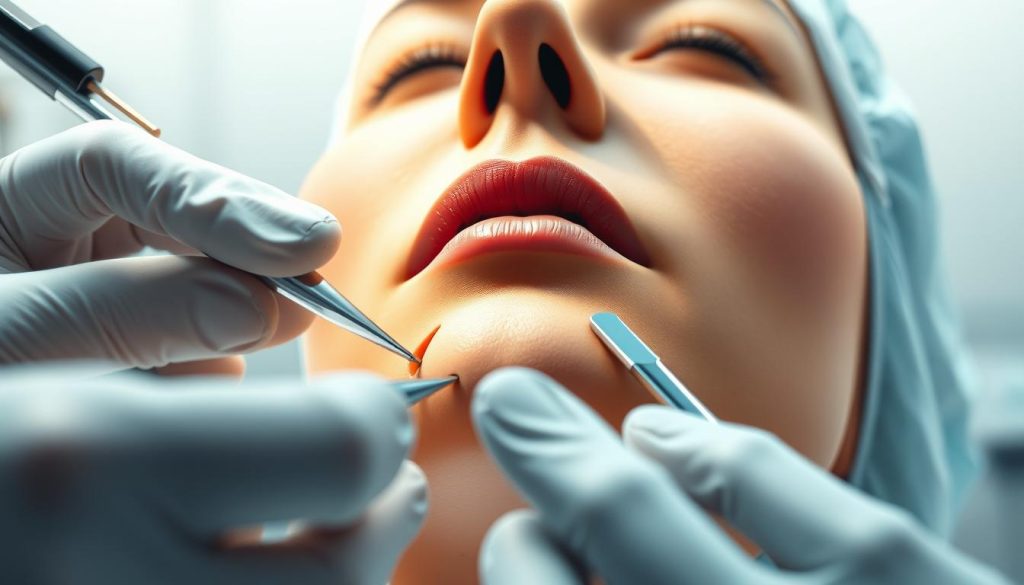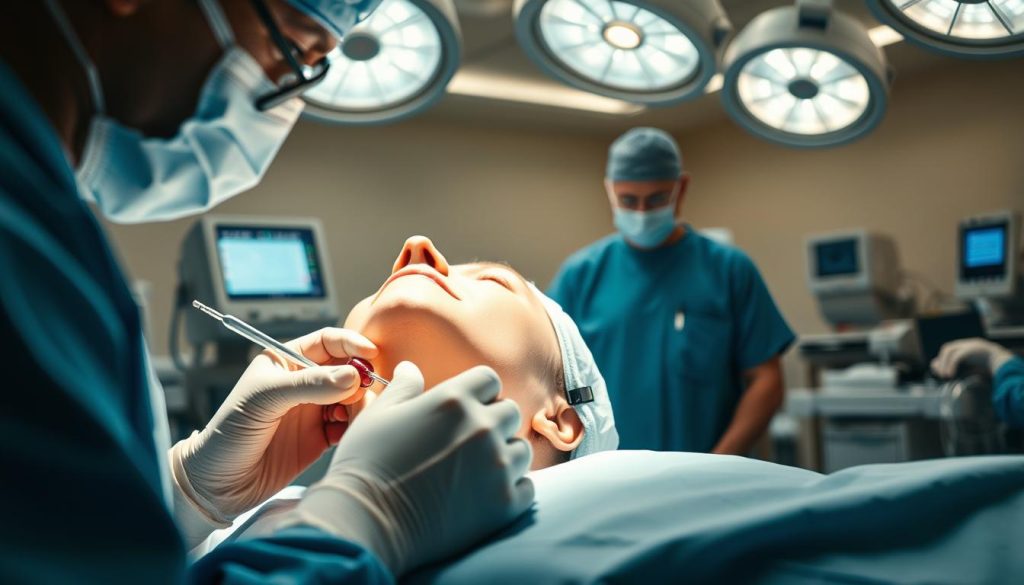Jawline surgery, also known as orthognathic surgery, is a procedure designed to reshape the jaw and chin. It can be used to enhance and define the jaw or reduce the size of the bone to give the chin a slimmer appearance.
Modern surgery techniques have evolved, offering patients more options with less invasive approaches and improved recovery times. These procedures can address both functional issues, such as misalignment, and cosmetic concerns related to facial balance.
By understanding the different types of surgeries available, patients can make informed decisions about which procedure might best address their specific needs.
Key Takeaways
- Jaw plastic surgery encompasses various procedures to reshape or realign the jaw and chin.
- These surgeries can address functional and cosmetic concerns.
- Modern techniques offer less invasive approaches and improved recovery times.
- Understanding available surgeries helps patients make informed decisions.
- Jawline surgery can enhance facial balance and profile.
What Is Jaw Plastic Surgery?
The term “jaw plastic surgery” refers to a surgical procedure that corrects and enhances the jawline and chin for both functional and aesthetic purposes. Jawline surgery, also known as orthognathic surgery, can reshape the jaw and chin to achieve better facial balance and proportion.
Jaw plastic surgery encompasses a range of procedures that address various concerns, from correcting misalignments and functional issues to enhancing the overall appearance of the jawline. This type of surgery can be used to either enhance and define the jaw or reduce the size of the bone to give the chin a slimmer look.
Defining Orthognathic Surgery
Orthognathic surgery refers to surgical procedures that correct conditions of the jaw and face related to structure, growth, sleep apnea, TMJ disorders, and malocclusion problems. This type of surgery is designed to address functional issues that affect a patient’s quality of life.
By correcting these conditions, orthognathic surgery can significantly improve a patient’s ability to chew, speak, and breathe properly. It can also enhance the overall aesthetic appeal of the facial profile.
Common Reasons for Jaw Surgery
Common reasons for seeking jaw surgery include correcting an underbite or overbite, addressing asymmetrical jaw development, and resolving chronic jaw pain or TMJ disorders. Some patients pursue jaw surgery to enhance their facial profile, create a more defined jawline, or achieve better facial harmony.
| Reasons for Jaw Surgery | Description | Benefits |
|---|---|---|
| Correcting Underbite/Overbite | Adjusting the alignment of the jaw to improve bite functionality | Improved chewing and speaking abilities |
| Addressing Asymmetrical Jaw Development | Correcting uneven growth or development of the jaw | Enhanced facial symmetry and aesthetics |
| Resolving Chronic Jaw Pain/TMJ Disorders | Treating pain and dysfunction in the temporomandibular joint | Reduced pain and improved jaw function |
Types of Jaw Plastic Surgery Procedures
There are multiple types of jaw plastic surgery, each catering to different needs and aesthetic goals. These procedures can be broadly categorized into three main types: jaw reduction surgery, jaw enhancement and implants, and corrective jaw surgery.
Jaw Reduction Surgery
Jaw reduction surgery involves carefully removing excess bone to create a slimmer, more contoured jawline. This procedure is often used in facial feminization surgeries to smooth out protrusions near the ears and give the face an overall slimmer appearance.
Jaw Enhancement and Implants
Jaw enhancement procedures utilize custom implants to add definition and projection to an underdeveloped or recessed jawline. Chin implants are a type of enhancement that involves fitting an implant around the natural chin to create a more pronounced jawline.
Corrective Jaw Surgery
Corrective jaw surgery addresses functional issues by repositioning the upper jaw, lower jaw, or both to improve bite alignment and facial symmetry. This type of surgery is crucial for individuals with significant jaw misalignment or other functional problems.
Medical vs. Cosmetic Reasons for Jaw Surgery
The motivations behind jaw surgery can be broadly categorized into medical and cosmetic reasons. Understanding the distinction between these two categories is crucial for patients considering this procedure.
Treating TMJ Disorders and Functional Issues
Jaw surgery is often performed to address temporomandibular joint (TMJ) disorders, which cause chronic pain and difficulty with basic functions like chewing and speaking. Functional issues such as sleep apnea, breathing difficulties, and bite problems are also corrected through jaw surgery. These medical reasons are typically covered by insurance, as they are considered necessary for overall health.
| Medical Condition | Description | How Jaw Surgery Helps |
|---|---|---|
| TMJ Disorders | Chronic pain and difficulty with jaw movement | Corrects the alignment and function of the jaw |
| Sleep Apnea | Breathing difficulties during sleep | Improves airway passage |
| Bite Problems | Issues with the way upper and lower teeth align | Corrects bite alignment for better oral health |
Aesthetic Improvements and Facial Balance
Cosmetic motivations for jaw surgery focus on enhancing facial proportions, creating a more defined jawline, or balancing facial features for improved appearance. While insurance typically does not cover purely cosmetic enhancements, many patients seek jaw surgery for a combination of both medical and aesthetic reasons.

The Cost of Jaw Plastic Surgery
Jaw plastic surgery costs can vary significantly based on several factors. The complexity of the procedure, the surgeon’s experience, and the geographic location all play a role in determining the final cost.
Price Range and Factors Affecting Cost
The cost of jaw surgery can range from $6,500 to $56,000. Factors such as surgeon fees, facility costs, and anesthesia expenses contribute to the overall cost. Additionally, combining jaw surgery with other facial procedures can impact the total price.
Insurance Coverage Considerations
Insurance coverage for jaw surgery depends on the reason for the procedure. If the surgery is medically necessary to address functional issues, such as painful chewing or swallowing, insurance may cover part of the cost. However, if the surgery is for cosmetic reasons only, it is typically not covered.
Preparing for Your Jaw Surgery
Before undergoing jaw surgery, it’s crucial to understand the preparation process to ensure a smooth and successful procedure. Proper planning can make a significant difference in the outcome.
Initial Consultation and Planning
The initial consultation is a comprehensive process that involves facial analysis, medical history review, and a detailed discussion of goals and expectations with your surgeon. This step is vital in creating a personalized plan for your jaw surgery.
Pre-Surgery Preparations
Pre-surgical planning may include orthodontic work with braces placed 12-18 months before surgery to ensure proper tooth alignment. Patients must also follow specific pre-operative instructions, including stopping certain medications that could increase bleeding risk.
What to Bring to the Hospital
When preparing for your hospital stay, which may last 2 to 4 days, pack essentials like comfortable clothing, entertainment items, and oral hygiene supplies. It’s also important to arrange for someone to pick you up after the procedure.
The Jaw Plastic Surgery Procedure
The surgical procedure for jaw plastic surgery is tailored to the individual’s specific needs and goals. It involves a combination of techniques to achieve the desired outcome.
Anesthesia and Surgical Approach
Jaw surgery is typically performed under general anesthesia, ensuring the patient remains comfortable throughout the procedure. The surgical approach varies depending on the type of procedure, but most incisions are made inside the mouth to minimize visible scarring.
Step-by-Step Surgical Process
The surgical process involves cutting and repositioning the jawbone, securing it with titanium plates and screws, and potentially using jaw implants to enhance the facial structure. For jaw reduction, a small incision is made inside the mouth, and a laser or micro saw is used to shave off part of the bone.
Duration and Hospital Stay
The procedure typically takes 2 to 4 hours to complete, depending on the complexity of the surgery. The hospital stay can range from a day to several days, depending on the extent of the procedure and the patient’s recovery progress.
| Procedure Type | Duration | Hospital Stay |
|---|---|---|
| Jaw Reduction | 2-3 hours | 1-2 days |
| Jaw Enhancement | 2-4 hours | 1-3 days |
| Corrective Jaw Surgery | 3-4 hours | 2-4 days |

Recovery Timeline After Jaw Surgery
The journey to full recovery after jaw surgery is a multi-stage process that requires patience, proper care, and adherence to the surgeon’s instructions. This process can be broken down into immediate, short-term, and long-term phases, each with its unique characteristics and requirements.
Immediate Post-Op Period (Days 1-7)
The initial recovery phase is marked by significant swelling and discomfort. Patients are typically advised to follow a liquid or soft food diet and are prescribed medication to manage pain. Keeping the head elevated and avoiding strenuous activities are crucial during this period.
Short-Term Recovery (Weeks 1-6)
As the initial swelling subsides, patients start to see improvements. The diet can gradually be advanced to more solid foods, and normal activities can be resumed cautiously. However, strenuous exercise should still be avoided.
Long-Term Healing (Months 1-12)
Full recovery and the final results of jaw surgery become more apparent over the next few months. While most patients can return to work within 1-3 weeks, complete healing may take up to 12 months.
| Recovery Stage | Timeline | Key Activities |
|---|---|---|
| Immediate | Days 1-7 | Pain management, soft food diet, rest |
| Short-Term | Weeks 1-6 | Gradual return to normal activities, advancing diet |
| Long-Term | Months 1-12 | Complete healing, final results apparent |
Potential Risks and Side Effects
Jaw plastic surgery carries various risks and potential side effects that patients should be aware of. As with any surgical procedure, understanding these risks is crucial for making an informed decision.
Common Temporary Side Effects
Temporary side effects of jaw surgery may include significant swelling and bruising, numbness around the jaw and lips, and difficulty speaking or eating normally. These effects are typically short-lived and resolve on their own.
Serious Complications to Be Aware Of
More serious complications can occur, including infection, adverse reactions to anesthesia, nerve damage leading to permanent numbness, and implant rejection or displacement. While these are less common, they require immediate medical attention.
When to Contact Your Surgeon
Patients should be vigilant for warning signs that require immediate medical attention, such as excessive bleeding, severe pain uncontrolled by medication, or signs of infection. Prompt action can mitigate these risks and ensure a smoother healing process.
Alternatives to Jaw Plastic Surgery

For individuals considering jawline enhancement, there are several alternatives to surgery that can achieve desirable results without the need for an operation. These alternatives offer a range of options for those who are not ready or willing to undergo jaw plastic surgery.
Dermal Fillers and Botox
Dermal fillers and Botox are popular non-surgical options for enhancing the jawline. Dermal fillers can add definition to the jawline, with results lasting 6-18 months. Botox injections can slim the jawline by reducing the size of the masseter muscles, creating a more contoured appearance where the jaw meets the neck.
Non-Surgical Options for TMJ Issues
For those suffering from TMJ disorders, non-surgical treatments include night guards, physical therapy, muscle relaxants, and lifestyle modifications to reduce jaw tension. These alternatives provide less dramatic results than surgery but involve minimal downtime and significantly lower costs.
Finding the Right Surgeon for Your Jaw Surgery

The success of your jaw surgery largely depends on choosing a skilled and reputable surgeon. To find the right professional, consider the following key factors.
- Ensure the surgeon is board-certified in oral and maxillofacial surgery or plastic surgery.
- Review their before-and-after galleries to assess their work on jaw and chin implant procedures.
- During consultations, evaluate how thoroughly they explain the surgical process and discuss potential results and recovery.
- Consider their experience with your specific procedure, as techniques vary between chin implants and full jaw reconstruction.
- A good surgeon should make you feel comfortable asking questions and never pressure you into additional procedures.
By carefully selecting a qualified surgeon, you can ensure a successful outcome for your jaw surgery.
FAQ
What is the typical recovery time for jaw surgery?
The recovery time can vary, but generally, it takes around 6 weeks for the bone to heal significantly. However, it may take several months for the swelling to completely subside and the final results to be visible.
Will I be under general anesthesia during the procedure?
Yes, most surgeons use general anesthesia to ensure the patient’s comfort during the surgery. The type of anesthesia used may vary depending on the complexity of the procedure and the surgeon’s preference.
Are there any risks associated with jaw surgery?
As with any surgical procedure, there are potential risks and side effects, such as infection, nerve damage, and scarring. However, these risks can be minimized by choosing a qualified and experienced surgeon.
Can chin implants be used in conjunction with jaw surgery?
Yes, chin implants can be used to enhance the overall appearance of the lower jaw and chin. This can be done in conjunction with jaw surgery to achieve a more balanced facial profile.
How long does the surgery typically take?
The duration of the surgery can vary depending on the complexity of the procedure, but it typically takes around 2-4 hours to complete.
Will I experience pain after the surgery?
Some pain and discomfort are normal after jaw surgery. However, this can be managed with medications prescribed by the surgeon.
Can I undergo jaw surgery for purely cosmetic reasons?
Yes, jaw surgery can be performed for aesthetic purposes to improve the overall shape and appearance of the jawline and face. However, it’s essential to have realistic expectations and discuss your goals with a qualified surgeon.
Are there any non-surgical alternatives to jaw surgery?
Yes, there are non-surgical alternatives, such as dermal fillers and Botox, that can be used to enhance the appearance of the jawline and face. However, these alternatives may not provide the same level of correction as jaw surgery.
